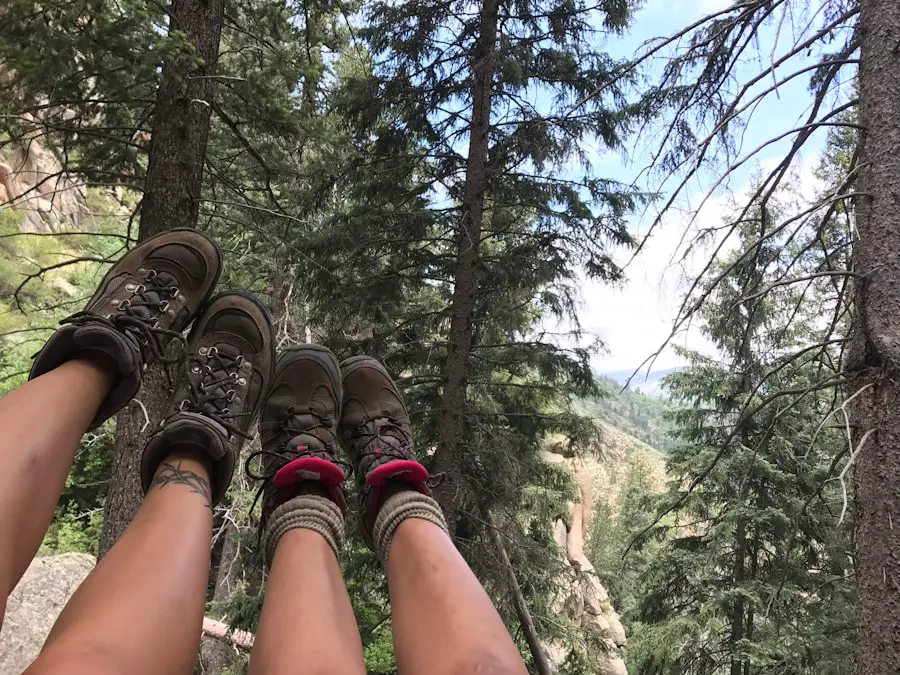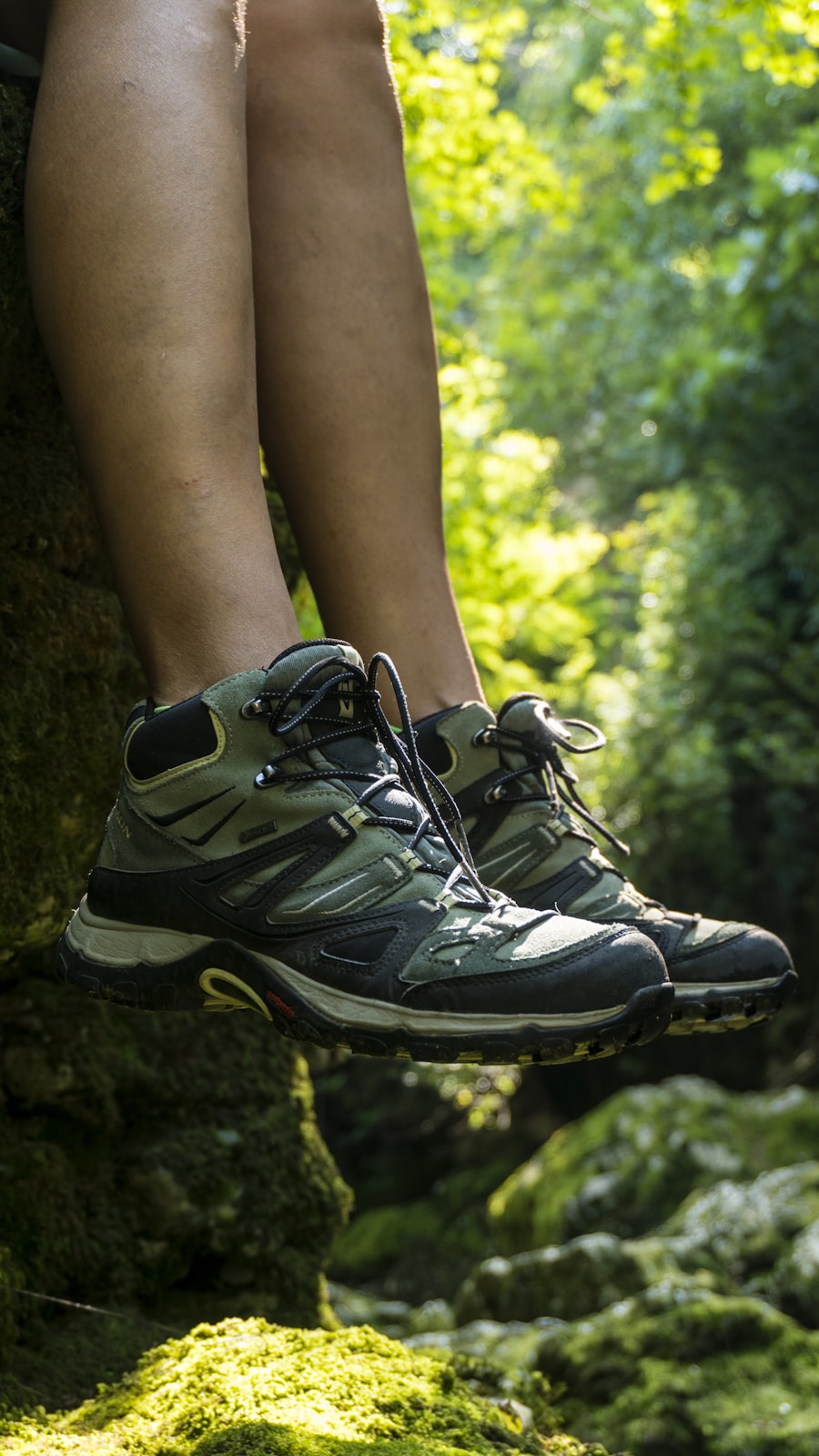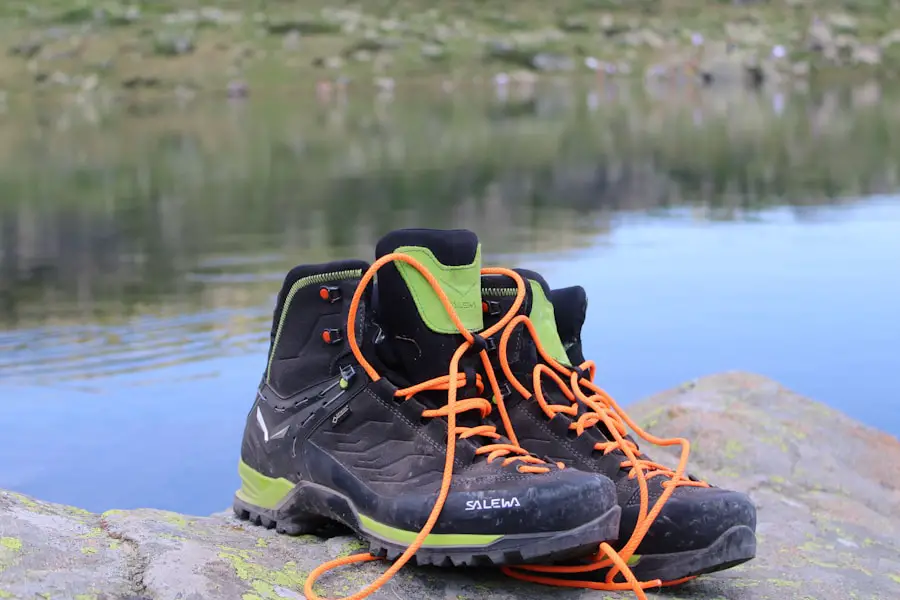When it comes to hiking, the significance of proper fit in footwear cannot be overstated. A well-fitted hiking boot serves as the foundation for a successful outdoor adventure, providing the necessary support and comfort to navigate various terrains. The right fit ensures that the foot is securely held in place, minimizing the risk of blisters and other injuries that can arise from excessive movement within the boot.
Moreover, a proper fit enhances overall stability, allowing hikers to traverse uneven surfaces with confidence. This is particularly crucial when tackling steep inclines or rocky paths, where every step counts. In addition to comfort and stability, the right fit can also influence a hiker’s performance.
Boots that fit well can improve energy efficiency, allowing hikers to conserve strength over long distances. Conversely, poorly fitting boots can lead to fatigue and discomfort, detracting from the overall experience. The psychological aspect of wearing well-fitted boots should not be overlooked either; knowing that your footwear is supportive and comfortable can boost morale and encourage hikers to push their limits.
Thus, investing time in finding the right fit is essential for both safety and enjoyment on the trails.
Key Takeaways
- Proper fit is crucial for hiking boots to ensure comfort and prevent injury
- Tight hiking boots can lead to blisters, hot spots, and even nerve damage
- A snug fit provides stability and support, reducing the risk of ankle injuries
- Finding the right balance between snugness and comfort is key for a perfect fit
- Tips for properly fitting hiking boots include trying them on in the afternoon and wearing the socks you plan to hike in
Potential Risks of Tight Hiking Boots
While a snug fit is often desirable in hiking boots, excessively tight footwear can lead to a host of problems. One of the most common issues associated with tight boots is the development of blisters. When the skin is subjected to constant friction against a constricting surface, it can become irritated and eventually form painful blisters.
This not only causes discomfort but can also hinder a hiker’s ability to continue their journey. In severe cases, blisters can become infected, leading to more serious complications that may require medical attention. Tight hiking boots can also restrict blood circulation to the feet, which can result in numbness and tingling sensations.
This lack of proper blood flow can lead to a condition known as “hiker’s foot,” where the toes may feel cold or lose sensitivity. Additionally, prolonged use of tight boots can contribute to long-term foot problems such as bunions or hammertoes, which can be both painful and difficult to treat. The risk of injury increases significantly when hikers are unable to feel their feet properly or when they are distracted by discomfort caused by ill-fitting footwear.
Benefits of a Snug Fit

Despite the potential risks associated with overly tight boots, a snug fit does offer several advantages when it comes to hiking footwear. A well-fitted boot should feel secure around the heel and midfoot while allowing enough room for the toes to move slightly. This snugness helps prevent excessive movement within the boot, which can lead to blisters and other injuries.
A secure fit also enhances stability on uneven terrain, providing hikers with the confidence needed to navigate challenging trails. Moreover, a snug fit can improve overall performance by ensuring that energy is efficiently transferred from the foot to the ground. When a boot fits properly, it allows for better control over foot placement and movement, which is particularly important during descents or when traversing rocky paths.
This level of control can reduce the risk of slips and falls, making for a safer hiking experience. Additionally, a snug fit can help maintain proper alignment of the foot and ankle, reducing strain on muscles and joints during long hikes.
Finding the Right Balance
| Metrics | Value |
|---|---|
| Work-Life Balance | 78% of employees consider it important |
| Productivity | Companies with a good work-life balance have 25% higher productivity |
| Employee Turnover | Companies with poor work-life balance have 33% higher turnover |
| Health and Well-being | Employees with a good work-life balance are 21% more likely to be healthy |
Achieving the right balance between snugness and comfort is crucial when selecting hiking boots. Hikers should aim for a fit that feels secure without being overly constrictive. One effective way to gauge this balance is by trying on boots at the end of the day when feet are naturally swollen from daily activities.
This ensures that the fit accommodates any changes in foot size that may occur during prolonged wear. Another important factor to consider is the type of socks that will be worn with the boots. Thick or cushioned socks may require a slightly looser fit to prevent discomfort, while thinner socks may allow for a more snug fit without compromising comfort.
It’s advisable to bring along the socks you plan to wear on your hikes when trying on boots to ensure an accurate fit. Additionally, some brands offer different widths or customizable options that can help achieve that perfect balance between snugness and comfort.
Tips for Properly Fitting Hiking Boots
To ensure that hiking boots fit properly, there are several key tips that hikers should keep in mind during the selection process. First and foremost, it’s essential to try on multiple pairs from different brands, as sizing can vary significantly between manufacturers. Each brand has its own unique design and sizing chart, so what fits well in one brand may not necessarily translate to another.
When trying on boots, pay attention to specific areas such as the heel, arch, and toe box. The heel should feel locked in place without slipping when walking; if it lifts even slightly, it could lead to blisters over time. The arch should provide adequate support without causing discomfort, while the toe box should allow for some wiggle room without feeling cramped.
A good rule of thumb is to ensure there’s about a thumb’s width of space between the end of your longest toe and the front of the boot when standing upright.
How Tight is Too Tight?

Determining how tight is too tight can be subjective and varies from person to person based on individual foot shape and preferences. However, there are some general guidelines that can help hikers assess whether their boots are excessively tight. If you experience any pain or discomfort while trying on boots, it’s likely that they are too tight for your feet.
A proper fit should feel snug but not painful; you should be able to walk around comfortably without any pinching sensations. Another indicator of an overly tight fit is if you notice any discoloration in your toes or if they feel cold or numb after wearing the boots for a short period. These symptoms suggest that circulation may be compromised due to excessive constriction.
It’s also important to consider how your feet feel after walking around in the boots for a while; if you find yourself constantly adjusting or shifting your feet within the boot due to discomfort, it may be time to explore other options.
The Impact of Terrain on Boot Fit
The type of terrain being navigated plays a significant role in determining how hiking boots should fit. For instance, when hiking on rugged trails with steep inclines or declines, a tighter fit may be beneficial for maintaining stability and control. In these situations, a secure heel lock can prevent excessive movement within the boot, reducing the risk of slips and falls.
Conversely, when traversing flatter or softer terrains such as sandy beaches or grassy fields, a slightly looser fit may be more comfortable as it allows for greater flexibility and breathability. Hikers should also consider seasonal changes; during colder months, thicker socks may necessitate a looser fit for added warmth without compromising circulation. Understanding how different terrains affect boot performance can help hikers make informed decisions about their footwear choices.
Finding the Perfect Fit
Finding the perfect fit for hiking boots is an essential aspect of preparing for outdoor adventures. It requires careful consideration of various factors including foot shape, sock thickness, and terrain type. By prioritizing proper fit and taking the time to try on multiple pairs, hikers can significantly enhance their comfort and performance on the trails.
Ultimately, investing in well-fitted hiking boots not only contributes to a more enjoyable experience but also helps prevent injuries that could derail future adventures. Whether you’re an experienced hiker or just starting out, understanding the nuances of boot fit will empower you to make informed choices that enhance your time spent in nature.
If you’re wondering if hiking boots are supposed to be tight, you may also be interested in learning about the best time to travel to Tennessee. This article provides a comprehensive guide on when to visit this beautiful state to make the most of your trip. Just like finding the right fit for your hiking boots, timing your visit to Tennessee can greatly enhance your overall travel experience.
FAQs
What is the purpose of hiking boots?
Hiking boots are designed to provide support, stability, and protection for the feet and ankles while hiking on various terrains. They are also meant to provide traction and prevent slipping.
Should hiking boots be tight?
Hiking boots should not be too tight, as this can lead to discomfort, blisters, and even foot injuries. However, they should fit snugly to provide support and prevent the foot from sliding around inside the boot.
How should hiking boots fit?
Hiking boots should have a snug fit, with enough room in the toe box to wiggle the toes but not so much room that the foot slides around. The heel should be secure and not lift up when walking.
What are the consequences of wearing hiking boots that are too tight?
Wearing hiking boots that are too tight can lead to discomfort, blisters, calluses, and even foot injuries such as bruised toenails or stress fractures. It can also affect the overall hiking experience and lead to decreased performance on the trail.
How can I ensure the right fit for hiking boots?
To ensure the right fit for hiking boots, it is recommended to try them on in the afternoon when the feet are slightly swollen, wear the same socks that will be worn while hiking, and walk around in the boots to assess comfort and fit. It is also helpful to consult with a knowledgeable salesperson or a professional boot fitter.
